|
This article on the Saab 37 Viggen
was scanned and OCRed from my purchased copy of the January American Aircraft Modeler.
Patricia Groves wrote the article and Björn Karlström added his trademark perfection
to a set of 4-view drawings. You can make a set of plans from the 4-view since fuselage
and airfoil cross-sections are shown. Thor's New Hammer
Here's Yer Bird, All You Ducted Fan Enthusiastsby Patricia T. Groves
In days of yore, when governments first began assembling their air forces, aeronautic
one-upmanship depended on a wood and wire technology. Designer/ builders knew that
the few thousand dollars (pounds, rubles or drachmas) required to produce a military
aircraft wouldn't bust the national economy1
It was a simplistic era during which the major concern was to find an engine any
engine, of almost any acceptable horsepower-that would run for 60 minutes in succession.
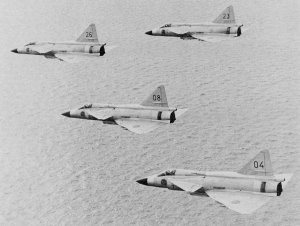 Saab 37 Viggen multi-purpose Mach 2 STOL
combat aircraft.
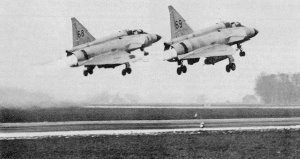 Removal
of some electronic gear and the forward fuel tank provided the second seat for the
Viggen trainers. Belly tank contains additional fuel.
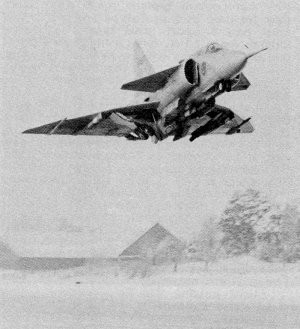 In order
to retract smoothly into the thin wing, the extra strong main landing gear units
are tandem. During 1640 ft. "no flare" type landings, the tandem arrangement provides
an added shock absorber. The thrust re-verser, triggered by switches on the landing
gear, can be preselected in the air.
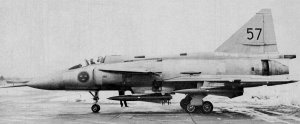 To reduce
scramble time, the Viggen can stand at con-tinuous alert, supported by a single
electrical power and air con-ditioning unit which is ejected during start-up sequence.
If no ground unit is available, the Viggen can start on its own.
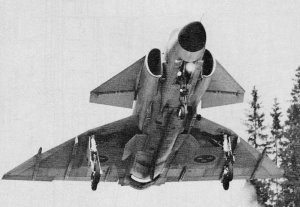 Capable
of a 1310 ft. takeoff run, a Swedish aluminum overcast departs one of their Air
Force's strategically located road bases.
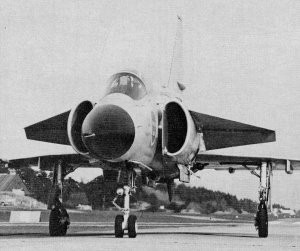 From brakes
off to 36,000 ft. takes two minutes. Landing speed is about 137 mph.
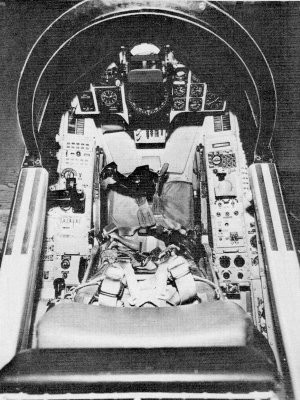 Cockpit
of Saab 37 Viggen.
When the call to war sounded, the world's first military aviators had but one mission-to
scout. Aboard the state of the art, gentlemen pilots plied their gentlemanly trade
while waving at one another in the clean, fresh air above the littered trenches.
Then came the moment one saluted, not with his hand but with a side arm.
As the technology that supplied those first little scout rolled merrily along, development
and production costs took off - jet-propelled. Until the advent of the Korean War
it was still possible (although not always practical) for most nations to "keep
up with the Joneses." And, conceivably, individual aircraft companies could independently
develop an airplane from scratch on a (relative) shoestring. Since then,
however, military aviation has been at the sufferance of each nation's budget considerations
and individual national priorities. Because of the sheer complexity of today's military
aircraft, the old-time day- or night fighters and the specialized bombers (per se)
are giving way to the military aircraft "system." Sweden, long a neutral
nation, alert to its own defenses and historically sympathetic to less technically
developed countries, has produced such a system in its Aircraft 37. Nicknamed Viggen
(Thunderbolt in English), it's basically a flying platform that is adaptable to
various primary and secondary mission requirements2. Both the AJ 37 Viggen (a fighter/ bomber
whose primary mission is that of attack and secondary mission is as a fighter),
and the SK 37 Viggen (a two seat trainer that is also combat adaptable), are currently
operational. In the prototype test or developmental stages are two strike/recche
versions. Their differences are mainly internal, and both the SF 37 (intended for
land reconnaissance), and the SH 37 (destined for sea surveillance duties), will
carry the appropriate punch. Scheduled for delivery in early 1975 is the
JA 37 fighter/interceptor, a planned follow-on to the current AJ 37. The JA 37,
with a more powerful engine and additional avionics, will differ little from the
present model, except for an internally mounted 30 mm Oerlikon KCA cannon. (On other
models, all armament is external to the aircraft.) Basically an all-weather
aircraft, the Viggen is scheduled to phase-out Sweden's Lansen and Draken airplanes
in the attack and reconnaissance roles. As a progression of the delta-wing Draken,
the Viggen has a tandem-delta wing which is flap-equipped on the canard surface.
This bold and attractive configuration gives it the high speed characteristics of
a delta wing while the foreplane gives it that added "plus" of an STOL's short field
performance. As a manned weapon system, the Royal Swedish Air Force's proposed
System 37 began in 1958 when development work on the Draken was peaking out. Included
in System 37's overall requirements were the aircraft with power plant, avionics,
ordnance, photo equipment, special ground-handling equipment and testing and training
equipment (including simulators). Because the Viggen represented a bigger,
more technically integrated pro-duct, it amounted to a whole "new aircraft, new
engine and new electronics based on new technical principles3. For the Swedes it constituted a major national
undertaking. The project, under constant review with the constant threat of economic
cutoff, is the result of a vast team work effort between the Swedish Air Force,
Saab-Scania (the prime contractor), and numerous Swedish and foreign (mostly American)
sub-contractors. In the fall of 1961 general specifications for a multi-purpose,
single-engine, single-seat aircraft with STOL capabilities were approved. In December
it was decided that the aircraft should be powered by a military version of Pratt &
Whitney's JT8D turbofan engine. Built under license by Volvo and fitted with a Swedish-built
after-burner, the engine allows the Viggen to cruise economically at low altitudes,
yet provides high reheat thrust when it has to get up 'n scat. It can operate at
Mach 2 at high altitudes or Mach 1.1 as low as 330 ft. off the deck. Actual
design, begun in October 1962, was frozen in May 1963. Including the probe, overall
length of the Viggen is 53 ft. 5 in. Span of the main wing is 34 ft. 9 in. Height
overall is 18 ft. 4 in. Since the airplane operates out of Sweden's network of underground
hangars, the main fin folds to reduce overall height to 13 ft. 1 in. Wherever
possible, integration of "off the shelf" items into the Viggen resulted in considerable
savings in overall development costs. These items were fitted into existing aircraft
and subjected to thorough testing in order to establish their compatibility with
other new or existing systems. All systems tie into a digital computer. In
order to control a potential Mach 2 airplane, it was necessary to come up with a
computer system that would get the pilot's workload down to tolerance level and
present understandable information without turning him into a blithering idiot drowned
in facts. Simulators were used to design placement of instruments and to determine
how much a man can absorb and still make decisions. A sophisticated airplane
with sophisticated innards can wind up a pretty "heavy" proposition. From the beginning,
Saab engineers had the Viggen on a strict diet to reduce all possible weight without
endangering aircraft integrity. They sweated over every pound. With nearly
25% of the skin area made up of inspection hatches, its fuselage (built along conventional
lines) is of high strength aluminum alloy composed, as much as possible, of bonded
honey-combed panels. (All control surfaces are honey-combed.) Because of its high
cost, titanium is used only in hot areas and in all standard bolts. Still and all,
maximum takeoff weight for the AJ 37 with standard armament loads is about 35,275
lb. In September 1964, the first of seven prototypes - each built for specific
systems-test purposes-was begun. It made its maiden flight on February 8, 1967 with
the other six prototypes following between then and July 2, 1970. By February 13,
1971 the first flight of a production AJ 37 was accomplished, and delivered into
Air Force service in June of that year. Of the 175 Viggens ordered (157
AJs and 18 trainers), 30 were in service as of March 1973. One independent expert
has called the Viggen "incomparably the best constructed aircraft this writer has
ever seen."4 Now with thousands of research, development and test flying hours
behind it, and with the inevitable bugs inevitably working out, production is scheduled
to go into the 1980s. Presented such possibilities in a ready-made machine, Australia,
the Netherlands and Switzerland are interested. Notes
1 The first use of the specific term "Military Type"
aircraft was on March 13, 1911 when the Curtiss Company received a $6000.00 order
from the U.S. Government. Robert B. Casari, (U.S. Military Aircraft 1908 to April
6, 1917), p. 1. 2 Except as especially noted, all data supplied by Saab-Scania.
3 Schroder, Olsson and Ljungkvist, "Viggen" Astronautics and Aeronau,tics,
December 1969, p. 26. See also: Canadian Aeronautics and Space Journal (Vol. 18,
No.6), June 1972, pp. l67ff. 4 Roy M. Braybrook, "The Fight for the Skys,"
Air Enthusiast (Vol. 4 No.6) June 1973, pp. 281.
 <click for
larger version>
 <click for
larger version>
Notice:
The AMA Plans Service offers a
full-size version of many of the plans show here at a very reasonable cost. They
will scale the plans any size for you. It is always best to buy printed plans because
my scanner versions often have distortions that can cause parts to fit poorly. Purchasing
plans also help to support the operation of the
Academy of Model Aeronautics - the #1
advocate for model aviation throughout the world. If the AMA no longer has this
plan on file, I will be glad to send you my higher resolution version.
Try my Scale Calculator for
Model Airplane Plans.
Björn Karlström Drawings:
Posted November 27, 2010
|